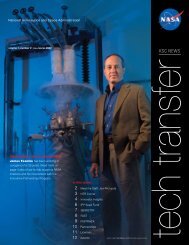2006-2007 - Kennedy Space Center Technology Transfer Office
2006-2007 - Kennedy Space Center Technology Transfer Office
2006-2007 - Kennedy Space Center Technology Transfer Office
- No tags were found...
Create successful ePaper yourself
Turn your PDF publications into a flip-book with our unique Google optimized e-Paper software.
Automated Method for Estimating Nutation Time Constant ModelParameters for <strong>Space</strong>craft Spinning on Axis<strong>Space</strong>craftNutationModelsFigure 1. DI configuration (with stand-off).Calculating an accurate nutationtime constant (NTC), or nutationrate of growth, for a spinning upperstage is important for ensuringmission success. <strong>Space</strong>craftnutation, or wobble, is caused by energy dissipationanywhere in the system. Propellant slosh in the spacecraftfuel tanks is the primary source for this dissipation and,if it is in a state of resonance, the NTC can become shortenough to violate mission constraints. The Spinning SloshTest Rig (SSTR), developed by NASA and SouthwestResearch Institute (SwRI), is a forced-motion spin tablewhere fluid dynamic effects in full-scale fuel tanks can betested in order to obtain key parameters used to calculatethe NTC. We accomplish this by independently varyingnutation frequency versus the spin rate and measuring forceand torque responses on the tank. This method was usedto predict parameters for the Genesis, Contour, and Stereomissions, whose tanks were mounted outboard from the spinaxis. These parameters are incorporated into a mathematicalmodel that uses mechanical analogs, such as pendulumsand rotors, to simulate the force and torque resonancesassociated with fluid slosh.Most recently, the SSTR was modified to simulate the onaxisspin motions of the centerline-mounted tanks used inthe Pluto New Horizons (PNH) and Deep Impact (DI)spacecraft (Figures 1 and 2). We varied diaphragm shapes(Figure 3), nutation frequencies (ratio of upper-motor toFigure 2. PNH configuration (withoutstand-off).Figure 3. Diaphragm shapes tested by SwRI.total revolutions per minute [RPM]), and fill levels ata constant spin rate of nearly 60.5 RPM to examinehow the various force and torque activity wouldinfluence the mechanical analog parameters. Datawas recorded while each fill level/diaphragm shapecombination underwent a nutation sweep wherespecific nutation frequencies ranged from 10 to90 percent of the total spin rate. After testing, it wasdetermined that the pendulum analog parameterscould be set to zero because very little resonanceactivity was observed in the force response along thetank wall, leaving the rotor analog available to be thesole influencer of the torque response. These ideal, ormassless, rotors have inertia only about their primaryaxis of spin. Their associated parameters includeinertia and spring/damping constants.The current method for identifying modelparameters involves laboriously hand-derivingequations of motion for both the SSTR andmechanical analogs and, by trial and error,82 Fluid System Technologies













